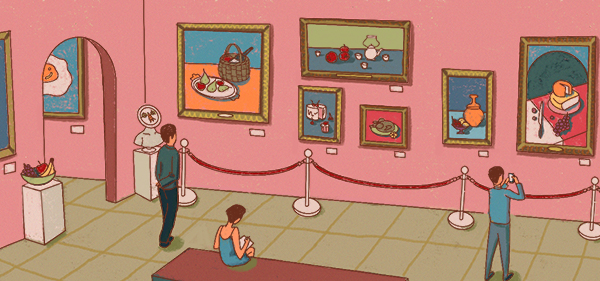More than just a mere subject, food as an art form became irrevocably intertwined with humanity.
During the Stone Age, cavemen used vegetable juice and animal fats as binding ingredients for paint. Meanwhile, the mosaics on Roman floors depict leftovers or “unswept” food from banquets. Even the Greeks attribute food to their gods and goddesses such as Bacchus, the god of wine, and Ceres, the goddess of grain.
Food drawings have also been found inside pyramids, burial walls, and chambers to portray what’s waiting for the deceased in the afterlife, believed that, through magic, it will nourish the dead. Paintings during the Renaissance also showed human features composed of fruits, vegetables, and flowers such as that of Roman emperor Rudolph II by Giuseppe Arcimboldo. Arcimboldo’s masterpiece became associated with Vertumnus, the Roman god for seasons and growth.
Food’s role in art has become a metaphor and a celebration of a theme. It reveals something beyond the surface—politics, gender, religion, class—as history has undoubtedly proven.
Western art: The wealthy and the ordinary
It was in the 15th century when artists took an interest in antiquity and the natural world. Still life became a primary source of inspiration with the Dutch being the primary proponent of this art. With this new perspective, food became a mirror of reality and a symbolism of the truths behind it. Food as art, during the time, was rooted in literature and paganism.
Other Impressionist artists revealed the social aspect of food in scenes of festive, refined collective dinners. Food, amid all the people and the surrounding space, was the central element.
Two hundred years later, still life became an independent genre and food became the center of this exquisite, detailed art form. There would be lavish food paintings of lobsters, game, and exotic citruses that would adorn the walls of owners who want to be identified with a privileged lifestyle and intellectual status. However, such images also became a reminder of the fleeting nature of luxury and the pitfalls of gluttony.
Some artists also proved that there was no need for the most precious food items as what Johannes Vermeer was able to translate in his famous painting “The Milkmaid.” Using the most common food (milk and bread) at the time as his subjects, the rich pigments, colors, and lighting transformed the mundane into influence—evidently, still manifested today.
Notable works of Filipino artists that feature ordinary life include Fernando Amorsolo’s 1906 painting “Fruit Vendors” that shows a local market scene, and Jose Blanco’s “Mother and Child” illustrating a mother breastfeeding her child amid a bountiful harvest.
In the Philippines, one prominent celebration that embodies food as art is the Pahiyas festival (pahiyas came from the word payas, which means decoration) in Lucban, Quezon. Every 15th of May, the townsfolk would decorate houses with fruits, vegetables, and colorful kiping or leaf-shaped wafer made from rice and food coloring.
The festival’s history dates back to the 15th century when farmers would bring their harvest from Mt. Banahaw to the church in honor of their patron saint Isidore the Laborer, the patron saint of farmers, laborers, and peasants.
By the end of the 19th century, it wasn’t just still life anymore—it was about real life. There were (finally) interactions between food and people such as farmers and peasants eating their daily meals. An example is Vincent van Gogh’s “The Potato Eaters.” Other Impressionist artists also revealed the social aspect of food in scenes of festive, refined collective dinners.
Modern and contemporary art: A social commentary
The changing nature of society is represented in art, and the 20th century didn’t fail to use food as the perfect subject to show just that. Edward Hopper’s 1930 painting “Tables for Girls” showed two individuals dining out (a luxury not everyone could afford) and two women, a cashier and a waitress—depicting new roles outside the home.
As the rise of a consumerist, mechanized society unfolded, this culture was critiqued through food in art. Mass-produced food became central subjects of pieces such as Andy Warhol’s “32 Campbell’s Soup Cans” lined up in a monotonous continuity and Roy Lichtenstein’s “Still Life with Crystal Bowl” showing fake and unsubstantial fruits (seemingly like magazine cut-outs) in a bowl.
Even photorealistic painters intensified lighting to manifest food as plastic and unnatural. Although multiple images of food products in a consumerist society detail prosperity, it also connotes how homogeneity can stifle individualism.
One remarkable work of Amorsolo is his 1937 painting “Fruit Pickers Under the Mango Tree” that features Filipino fruit gatherers—a piece created during the rise of women’s rights in the country. At that time, there was a plebiscite held for Filipino women on whether they should be extended the right to suffrage (over 90 percent voted affirmative). Seen in this particular painting of Amorsolo, in the same way that his other creations showcase the true value of Filipinos, is an illuminated image of one of the Filipina fruit gatherers, revealing true beauty and character.
Food became a medium for social interaction when people became elements of the artwork during a staged cooking in a gallery by artist Rirkrit Tiravanija. Kara Walker’s giant sugar-coated, styrofoam, female sphinx-like installation called “A Subtlety, or the Marvelous Sugar Baby” also touched on globalization, imperialism, and slavery (trading sugar for bodies, and bodies for sugar).
All these examples characterize food’s inseparable relationship with art and its enduring ability to be a powerful tool in translating and propelling transformative action.


